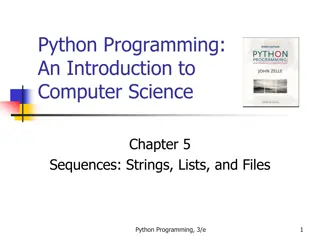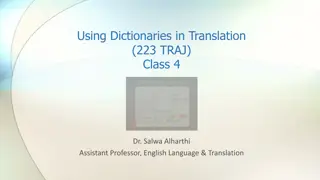Introduction to Lists and Dictionaries in Python
This lecture discusses Lists and Dictionaries in Python programming. It covers the differences between these two data structures, their usage, variable storage, and handling larger data sets. The session introduces Lists as containers for related data pieces and explains how to create, access, and manipulate list elements. It also touches on storing large amounts of data and the essential concepts of data structures in Python.
Download Presentation

Please find below an Image/Link to download the presentation.
The content on the website is provided AS IS for your information and personal use only. It may not be sold, licensed, or shared on other websites without obtaining consent from the author.If you encounter any issues during the download, it is possible that the publisher has removed the file from their server.
You are allowed to download the files provided on this website for personal or commercial use, subject to the condition that they are used lawfully. All files are the property of their respective owners.
The content on the website is provided AS IS for your information and personal use only. It may not be sold, licensed, or shared on other websites without obtaining consent from the author.
E N D
Presentation Transcript
Lecture 9 Lists & Dictionaries Bryan Burlingame 27 March 2019
Announcements Homework 6 due up front Homework 7 due next after break Read Chapter 12 & 13
Learning Objectives Introduce Lists Introduce Dictionaries Understand the differences between the two data structures and when to use one over the other
Variables and Values Recall: there are these things called values. Pieces of information (data) which have some characteristic (a data type), which can be operated on. Ex: 3.1415926 (a floating-point number or simply a float), 5 (an integer), Hello mom (a string) Values can be stored in variables, named locations of memory used to store data. Variables are created using the assignment operator = Ex: salary = 100000
Bigger Data Variables have a bit of a scale problem. Ex: How would we store all of the salaries for all of the workers of America?
Bigger Data Variables have a bit of a scale problem. Ex: How would we store all of the salaries for all of the workers of America? We need some mechanism to store large amounts of related data Python has a few, we ll start with the simplest: lists
Lists Lists are a container designed to hold a sequence of pieces of related data Each piece of data in a list is referred to as an element of the list or an item in a list Lists are intrinsic (built-in) to Python and a key feature of the language A list value is created by enclosing a set of data in square brackets, separating each piece of data by a comma Note: Lists a just considered a value; therefore, lists can contain lists The inner lists are said to be nested in the outer lists
Lists and Variables Predictably, lists can be stored in a variable using the assignment operator Accessing an element of a list is done using the square bracket operator The number in the square bracket is called the index
Lists and Variables Predictably, lists can be stored in a variable using the assignment operator Accessing an element of a list is done using the square bracket operator The number in the square bracket is called the index Note: indices start at 0, not 1, in Python How would we print weird from n?
Lists and Variables Predictably, lists can be stored in a variable using the assignment operator Accessing an element of a list is done using the square bracket operator The number in the square bracket is called the index Note: indices start at 0, not 1, in Python How would we print weird from n? Print the 3rdelement of the 3rdelement
Indices An index is simply an integer, so any expression which generates an integer can be used as an index Negative indices return values counting from the end of the list
Mutability Lists are mutable, the members can be changed Individual members are accessed using the same square bracket operator
in Operator The in operator reports true if a given value is an element of a list
Traversing a list Traversing a list, iterating over a list element by element and performing some set of operations on the element is most easily done with the in operator and a for loop This construct is useful when the programmer needs to access, though not update each member of the list
Traversing a list To update, use the indices Note: the len function returns the number of elements in a list
Other list Operators + addition concatenates two lists * replicates a list n times
Slice Operator It is possible to extract sublists using the slice operator, : The slice operator returns a list comprised of the elements from some index to some other index in the form of list[x:y] Note: the sublist is comprised of values from index x to index (y 1) If x is omitted, the beginning of the list is assumed. If y is omitted, the end of the list is assumed. If both are omitted, the whole list is returned If y doesn t come after x, an empty list is returned, though negative indices are allowed to find y
List methods Methods are functions which operate on some item and are a part of that item. These items are called objects. Objects will be more formally introduced later in the course. Methods are invoked using the . (dot) operator Lists have a large number of methods
List methods A few useful methods list.sort(), sorts the list Note: the list was sorted in place. list.sort returns none list.append(value) adds an element to the end of a list list.extend(list2) takes all the values of list2 and appends them to list
Removing elements If the element to be removed location is known and the value is desired, use the pop method. pop without an index number, returns the last element of the list If the value isn t desired, use the del operation If the location isn t known, yet the value is, use the remove method. Note: it only removes the first instance of the value
Dictionaries A dictionary is like a more general form of a list Dictionaries are comprised of a collection of indices (keys) and a collection of related values Dictionaries map a value to a key Referred to as a key-value pair We ve seen this with lists Lists map an index (an integer) to a value Note that unlike strings and lists, dictionaries are not sequences. There is no implied ordering to the key-value pairs.
Dictionaries A dictionary is like a more general form of a list Dictionaries are comprised of a collection of indices (keys) and a collection of related values Dictionaries map a value to a key Referred to as a key-value pair We ve seen this with lists Lists map an index (an integer) to a value Note that unlike strings and lists, dictionaries are not sequences. There is no implied ordering to the key-value pairs.
Declaring a Dictionary Declaring a dictionary can be accomplished by invoking the dict() function Notice the difference in the brackets Square brackets [] indicate a list Curly brackets {} indicate a dictionary
Declaring a Dictionary Much like a list can be declared by initializing a variable to an empty list, a dictionary can be declared by initializing a variable to an empty dictionary
Assigning Members To assign a member, use square brackets with an immutable value, such as a string, as the key To access a member, use the same mechanism If one attempts to access a key which does not exist, an exception occurs indicating a KeyError
Short Form Assignment Attempting to print a dictionary displays a set of key-value pairs within curly braces That same format can be used to populate a dictionary Note: though these examples seem to indicate the order of assignment is retained, dictionaries are not a sequence
Obtaining a list of keys When a dictionary is a parameter to the list function, the keys are returned in a list The sorted function returns a list of sorted keys
in operator and len in checks to see if a key exists in the dictionary, not a value len returns the number of key- value pairs
lists as values lists can be values of a dictionary Note the order of the keys/indices
Reduction Many times, it is useful to reduce a sequence to some value. This requires iterating over the sequence, performing some reducing operation, such as adding all the value in a sequence to some sum Side note: this algorithm is called accumulation and the variable total is called the accumulator It is so common, that there is a built-in function to handle it: sum(list)
Dictionary Traversal for loops over the keys of the dictionary Those keys can be used to access the values There is no automatic way to find a key given a value, though you could use a for loop and a comparison
Lists of dictionaries of lists of Dictionaries can be values stored in lists which can be values stored in dictionaries This allows for storage of complex, related data Sometimes these collections of data are called records Note: I tend to use the plural for structures which refer to many things and the singular for structures which refer to one thing. This is a common style choice.
Looping through complex records Nested for loops can iterate over these complex records Given the previous students, let s print their average grades
Functions and Containers Containers can be passed to a function just like any value Unlike scaler values, however, containers are passed by reference For simple scaler values, Python copies the value into the receiving variable Notice how x in __main__ doesn t change
Functions and Containers Instead of copying all of the values of x to the local x for adder, Python hands the function a reference For now, this means changes to a container in a function affects the container from the calling function Notice how x in __main__ does change for a list We ll cover this in more detail in the future
Resources Downey, A. (2016) Think Python, Second Edition Sebastopol, CA: O Reilly Media (n.d.). 3.7.0 Documentation. 6. Expressions Python 3.7.0 documentation. Retrieved September 11, 2018, from http://docs.python.org/3.7/reference/expressions.html

 undefined
undefined
























